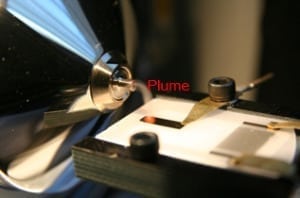Last year, the director of the UW School of Pharmacy Mass Spectrometry Center, Dave Goodlett, developed a method to make mass spectrometry research easier. The method, known as Surface Acoustic Wave Nebulization (SAWN), simplifies how researchers introduce nonvolatile compounds — such as proteins, lipids and small molecules like caffeine — into a mass spectrometer for analysis. Historically, researchers working with nonvolatile samples had to choose between methods that are easy to perform or that perform well. The SAWN method (pictured at left) combines ease of use with high performance.
With the help of the UW Center for Commercialization (C4C), Goodlett and Dr. Patrick Langridge-Smith of the University of Edinburgh have formed a company, Deurion LLC, to further develop this technology and make it commercially available. In December, Deurion received a $150,000 National Science Foundation grant to continue its work. This grant builds on a UW C4C Gap Fund of $50,000 that Goodlett received last summer to construct a prototype SAWN device.
UW postdoctoral fellows Scott Edgar and Sung Hwan Yoon, members of the Goodlett Lab, are currently working as scientists with Deurion. Edgar is the manager and senior scientist responsible for managing the commercialization of the SAWN technology. Among other things, he and Yoon are writing an interface and developing the wiring system that will allow scientists to plug their laptop into the mass spectrometer and run the SAWN method from their laptop. They’re also working to increase the sensitivity of the method — detecting smaller and smaller amounts of material.
Surface acoustic wave technology was invented in the 1960s and is used today in applications including electronic filters or sensors. However, the technology for ionizing samples specifically for mass spectrometry is a recent development.
Goodlett’s long-term goal for his company is for the new technology to be adopted by mass spectrometry research centers throughout the country. The SAWN method is so easy to use that practically anyone could master it in a few minutes, according to Goodlett. Improving the performance and ease of mass spectrometry will benefit scientists across disciplines — including in the life sciences, the pharmaceutical industry and homeland defense as well as those working in clinical research.
Mass spectrometers also play an important role in an area of investigation popularized by several TV shows in recent years — crime scene investigation. “Mass spectrometers are constantly seen on crime lab shows,” said Goodlett. “These instruments are used to detect explosives or drugs in someone’s system in a crime scene. If the SAWN method became a standard practice, it could speed up important analysis in a crime lab.”
Goodlett and his team are currently in the process of creating a scientific advisory board for Deurion. In addition, they are applying for a Phase 2 National Science Foundation grant to extend funding for another two years. UW C4C has also secured the intellectual property rights to the SAWN method and filed a patent application.
This is not the first start-up company to have spun off from work conducted at the School of Pharmacy. In the past decade, faculty research has also led to the creation of the Department of Pharmaceutics’ Drug Interaction Database and the Seattle biotech company Impel Neuropharma, co-founded by Professor of Pharmaceutics Rodney Ho and alumnus John Hoekman, PhD, ’10. Further, individual faculty members have made many discoveries over the years that have resulted in intellectual property rights.
While Goodlett is excited about this new undertaking, he’s also realistic about the challenges and unknowns ahead. Regardless, he said, “I am learning a lot. I am also glad that this company is providing such a great opportunity for my postdocs.”
Indeed, postdoctoral fellow Scott Edgar is the principal investigator on the NSF grant.
“This is unusual in academia because universities don’t allow postdocs to write their own grants,” said Goodlett. “But because the grant was on behalf of our company, Scott has been able to successfully write and manage the grant. No matter what happens, that will be a great thing for him to have on his CV.”
To see footage of the SAWN method, click here.
~March 9, 2012
